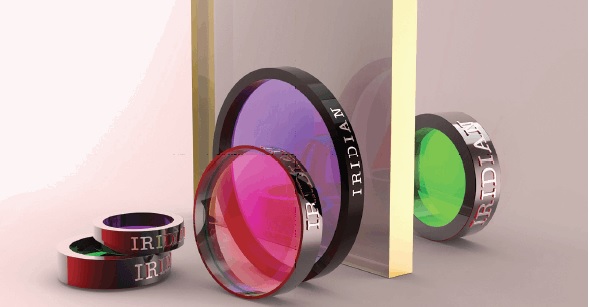Dichroic filters are designed to selectively allow wavelengths within a specific transmission band to pass through while reflecting all other colors and for beam steering purposes. They are particularly useful in optical applications where the detector is perpendicular to the optical light source. This is because dichroic filters allow for the separation of different incident wavelengths at a 45-degree angle.
Therefore, a single dichroic filter can be used to both direct light from a source and to remove any unwanted wavelength contributions from the intense light source used from the experiment that may produce signals several orders of magnitude larger than the sample and result in saturation of the detector or simply contaminate the final spectrum. This is ideal for a wide range of spectroscopy applications.
What is a Dichroic Filter Used For?
Dichroic filters are commonly used for such purposes in Raman spectroscopy, which uses high-intensity laser light to illuminate samples. Analyses are derived from various emission signals such as the inelastically scattered Stokes and/or Anti-Stokes light. This essentially yields a spectral fingerprint of the sample, however, the emission wavelengths are typically very close to those of the excitation source. Dichroic filters can therefore be used to steer the incident laser beam to the sample, and to attenuate reflected laser light—stopping it from reaching the detector—while simultaneously transmitting the weak emission signal.
High-quality dichroic filters are also used in some spectrometer designs.
How Dichroic Filters Work
Dichroic filters work using thin-film interference to selectively interfere with certain wavelengths destructively. Commonly, dichroic filters are made using multiple layers in a thin-film cavity comprising materials with different refractive indices that are coated onto an optical glass substrate. When light passes through a filter at a given incident angle, some light will be reflected by each of the thin layers within the cavity. Due to the path length difference between the reflection points, the reflected light interferes with the incident light, resulting in only certain wavelengths being reflected and the rest being transmitted.
As the exact path length differences are dependent on the incident angle of the incoming light, the performance of dichroic filters is highly angle-dependent. Typically, increased angles of incidence result in the filter shifting towards shorter wavelengths. Other important design considerations when choosing filters include whether the application requires sharp cut-on or cut-offs in spectral filtering.
Dichroic Filters from Iridian
As world leaders in custom optical filter solutions, Iridian Spectral Technologies offer a range of dichroic filters, including long and short-pass filters. Our filters offer excellent transmission (> 95 %) in the bandpass region as well as steep cut-on and cut-off for blocking ranges.
Iridian Spectral technologies also have the in-house expertise to design custom dichroic filters for specific applications. To find out more about our dichroic filters, contact us today.



